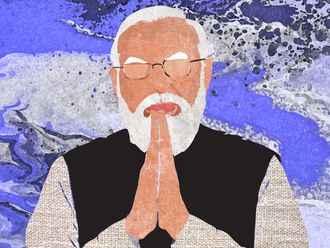The growing tensions in Iran after anti-government protests erupted across different cities over the country’s economic policies remained the focus of global media this week.
The Guardian noted, “It takes bravery, perhaps incaution, to forecast what will unfold in the year ahead. It would be true folly to predict what will happen in Iran in the coming hours and days. The protests quickly spread across provinces to become the largest since the huge pro-reform rallies of 2009’s green movement. There have been unprecedented calls of “Death to [Ayatollah Ali] Khamenei”, the supreme leader, and even reports of people lauding the monarchy toppled in the 1979 revolution. Other chants have attacked Tehran’s geopolitical ambitions: “Let go of Syria, think about us.” It is Iran’s growing heft in the region, and the sharpening of its rivalry with Saudi Arabia, that makes internal turbulence more significant than ever. The brutal repression of the green movement weighs heavily on people’s minds. The interior minister warned that those who disrupt public order will “pay the price”; the Revolutionary Guards have threatened an “iron fist”; protesters have died; some social media apps have been blocked.”
Commenting on the state of religious imperialism in Iran, the Wall Street Journal editorialised, “Iran’s Revolutionary Guard Corps, the regime’s paramilitary arm, is heavily involved in the economy and uses business to finance its operations and elite lifestyle. Iranians are also frustrated that the mullahs are spending so much of their national wealth to build a Shiite version of the Persian empire to dominate the Middle East. The Revolutionary Guards are financing the Hezbollah troops fighting as mercenaries to prop up Bashar Al Assad in Syria. They’re also financing militias in Yemen against the Saudis and in Iraq to guarantee Iranian influence in Baghdad. Religious imperialism is expensive, as is the ballistic-missile development the regime continues despite the nuclear deal.”
The Independent wrote, “For if the world was watching the true beginnings of a liberal revolution in Iran, then there would be some hope that the new year will bring freedom to Iran and an end to Iranian interference in the affairs of its neighbours. The chances, however, are that the protests in Iran will lead only to a perhaps prolonged period of unrest, with pro-regime counter-protests and what the authorities call their “iron fist” being slammed down as hard as ever on dissent. These riots have resulted in fatalities, and more may well follow. The determination, if not desperation, of the protesters is undoubted. No Iranian lightly takes to the streets to chant “death to the Ayatollah”. It is a reminder of what has long been true: that the young and better-educated Iranians yearn for their country to rejoin the world community and for them to enjoy the liberty of watching, reading and voting in genuinely democratic elections as they wish. The state has a formidable array of weapons at its disposal with which to survive this challenge to its power, from propaganda to the military. The state, in this case, means that part of it run by the clerics and answerable to an autocratic “supreme leader” rather than the civilian government that somehow tries to function alongside it.”
The Iranian regime is responding with a mix of warning and rhetoric. In 2009, the protests led by the ‘Green Movement’ were sparked by anger at the perceived manipulation of presidential election results against the reformist candidates and in favour of the incumbent president, Mohammad Ahmadinejad, a comment piece in The Hindu highlighted. “Despite support from the reformist factions, supreme leader (at that point) prevailed again over the protesters by declaring Ahmadinejad as President. Reports from Iran say the protesters are no longer taking about reform but are demanding an end to the clerical regime. Although the unrest was triggered by economic grievances, it has quickly escalated to include political demands and appears to have spread across Iran,” the op-ed summarised.





_resources1_16a31069e4e_small.jpg)






